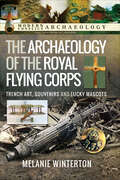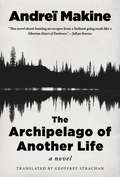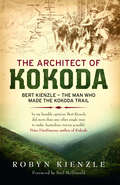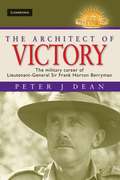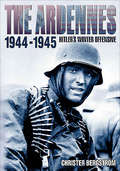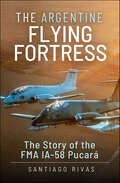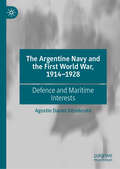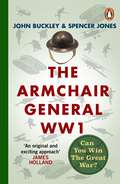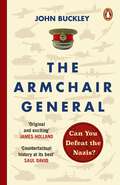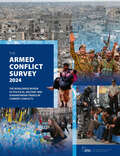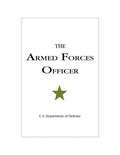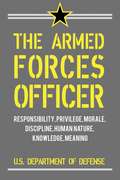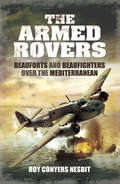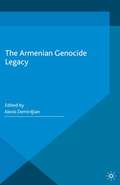- Table View
- List View
The Archaeology of the Royal Flying Corps: Trench Art, Souvenirs and Lucky Mascots (Modern Conflict Archaeology)
by Melanie Winterton"Winterton’s book is a good introductory effort on the haptic environment of World War I aviators and their personal artifacts."—The Journal of the Air Force Historical FoundationArchaeology provides a fascinating insight into the lives of the aviators of the First World War. Their descriptions of the sensation of flying in the open cockpits of the primitive warplanes of the day, and the artifacts that have survived from these first years of aerial combat, give us a powerful sense of what their wartime service was like and chart the beginning of our modern understanding of aviation. But the subject hasn’t been explored in any depth before, which is why Melanie Winterton’s pioneering book is so timely. Hers is the first study of the trench art, souvenirs and lucky mascots associated with the Royal Flying Corps which, in an original way, tell us so much about the experience of flying on the Western Front a century ago. Extensive quotations from the memoirs of these early airmen are combined with an analysis of the artifacts themselves. They convey something of the fear and anxiety the airmen had to grapple with on a daily basis and bring out the full significance of the poignant souvenirs they left behind. Pieces of crashed aeroplane – wooden propellers, strips of linen, fragments of metal – were recycled and circulated during the war and afterwards became the focus of attention in the domestic home. As Melanie Winterton demonstrates, these items connected the living with the deceased, which is why they are so strongly evocative even today.
The Archaeology of the Second World War: Uncovering Britain's Wartime Heritage
by Gabriel MoshenskaThe Second World War transformed British society. Men, women and children inhabited the war in every area of their lives, from their clothing and food to schools, workplaces and wartime service. This transformation affected the landscapes, towns and cities as factories turned to war work, beaches were prepared as battlefields and agricultural land became airfields and army camps. Some of these changes were violent: houses were blasted into bombsites, burning aircraft tumbled out of the sky and the seas around Britain became a graveyard for sunken ships. Many physical signs of the war have survived a vast array of sites and artefacts that archaeologists can explore - and Gabriel Moshenskas new book is an essential introduction to them. He shows how archaeology can bring the ruins, relics and historic sites of the war to life, especially when it is combined with interviews and archival research in order to build up a clear picture of Britain and its people during the conflict. His work provides for the first time a broad and inclusive overview of the main themes of Second World War archaeology and a guide to many of the different types of sites in Britain. It will open up the subject for readers who have a general interest in the war and it will be necessary reading and reference for those who are already fascinated by wartime archaeology - they will find something new and unexpected within the wide range of sites featured in the book.
The Archer's Tale (Grail Quest #1)
by Bernard CornwellA brutal raid on the quiet coastal English village of Hookton in 1342 leaves but one survivor: a young archer named Thomas. On this terrible dawn, his purpose becomes clear -- to recover a stolen sacred relic and pursue to the ends of the earth the murderous black-clad knight bearing a blue-and-yellow standard, a journey that leads him to the courageous rescue of a beautiful French woman, and sets him on his ultimate quest: the search for the Holy Grail.
The Archers: perfect for all fans of The Archers
by Catherine MillerIts 1943 and the war continues on in Ambridge. But the minds of the villagers are focused a little closer to home… For many centuries, a local tradition has told of a mystic living in a hermit&’s cave just outside the village. Legend tells that she has hidden her prophecies around the area, but none have ever been found. When a visiting academic arrives in Ambridge, there for war work, but personally intrigued by the prophecies, he becomes determined to find out more. And as the prophesies are uncovered, it appears the mystic knows more than anyone could have predicted – and when they become personal and foretell the death of a local Ambridgian, the village is united in surprise. Meanwhile, the war will end and some will come home – and some never will. And those who do will find that life in Ambridge has been changed….
The Archidamian War
by Donald KaganThis book, the second volume in Donald Kagan's tetralogy about the Peloponnesian War, is a provocative and tightly argued history of the first ten years of the war. Taking a chronological approach that allows him to present at each stage the choices that were open to both sides in the conflict, Kagan focuses on political, economic, diplomatic, and military developments. He evaluates the strategies used by both sides and reconsiders the roles played by several key individuals.
The Archipelago of Another Life: A Novel
by Andreï Makine"This novel about hunting an escapee from Stalinist gulag reads like a Siberian Heart of Darkness." —Julian Barnes On the far eastern borders of the Soviet Union, in the sunset of Stalin&’s reign, soldiers are training for a war that could end all wars, for in the atomic age man has sown the seeds of his own destruction. Among them is Pavel Gartsev, a reservist. Orphaned, scarred by the last great war and unlucky in love, he is an instant victim for the apparatchiks and ambitious careerists who thrive within the Red Army&’s ranks. Assigned to a search party composed of regulars and reservists, charged with the recapture of an escaped prisoner from a nearby gulag, Gartsev finds himself one of an unlikely quintet of cynics, sadists, and heroes, embarked on a challenging manhunt through the Siberian taiga. But the fugitive, capable, cunning, and evidently at home in the depths of these vast forests, proves no easy prey. As the pursuit goes on, and the pursuers are struck by a shattering discovery, Gartsev confronts both the worst within himself and the tantalizing prospect of another, totally different life.
The Architect of Kokoda: Bert Kienzle - The Man Who Made the Kokoda Track
by Robyn KienzleIn my humble opinion, Bert Kienzle did more than any other single man to make Australian victory possible.' Peter FitzSimons, author of KokodaIn 1942, when the Japanese had invaded Papua New Guinea and the Australian soldiers sent to hold them back thought victory was impossible, one man, Bert Kienzle, changed the course of history.This charismatic man, well known in Papua for having run gold mines and plantations there, was charged with the seemingly impossible task of establishing a trail across the forbidding Owen Stanley Range in just a few short months.Out of jungle and mud, Kienzle carved a working transport route that his handpicked teams of native bearers, the now famous Fuzzy Wuzzy Angels, would work on alongside the Australian troops ensuring that the men got the food, munitions and medical support they needed. The feats that these men performed were heroic, and their endurance as they transported supplies along the Trail unparalleled. Bert Kienzle lived an amazing life and the transport route he established ? the legendary Kokoda Trail ? made Australia?s victory possible.This is his story.
The Architect of Victory
by Peter J. DeanLieutenant General Sir Frank Berryman is one of the most important, yet relatively unknown officers in the history of the Australian Army. Despite his reputedly caustic personality and noted conflicts with some senior officers, Berryman was crucial to Australia's success during the Second World War. But did the man known as 'Berry the Bastard' deserve his reputation? Bold, calculating and talented, Berryman was at the forefront of operations that led to the defeat of the Japanese, and his operational planning secured Australia's victories at Bardia, Tobruk and in New Guinea during the Pacific War. With access to rare private papers, Peter Dean charts Berryman's special relationships with senior US and Australian officers such as MacArthur, Chamberlin, Blamey, Lavarack and Morshead, and explains why the man poised to become the next Chief of General Staff would never fulfil his ambition.
The Architecture of Confinement: Incarceration Camps of the Pacific War (Studies in the Social and Cultural History of Modern Warfare)
by Anoma Pieris Lynne HoriuchiIn this global and comparative study of Pacific War incarceration environments we explore the arc of the Pacific Basin as an archipelagic network of militarized penal sites. Grounded in spatial, physical and material analyses focused on experiences of civilian internees, minority citizens, and enemy prisoners of war, the book offers an architectural and urban understanding of the unfolding history and aftermath of World War II in the Pacific. Examples are drawn from Australia, New Zealand, Singapore, Japan, and North America. The Architecture of Confinement highlights the contrasting physical facilities, urban formations and material character of various camps and the ways in which these uncover different interpretations of wartime sovereignty. The exclusion and material deprivation of selective populations within these camp environments extends the practices by which land, labor and capital are expropriated in settler-colonial societies; practices critical to identity formation and endemic to their legacies of liberal democracy.
The Architecture of Leadership
by Donald T. Phillips James M. LoyThe Architecture of Leadership is a simple but effective toolkit for leaders, whose main theme is "preparation = performance." Using the elements of architecture, they begin with a foundation of character and values, move to a floor representing a drive to achieve combined with the capacity to care, and continue with the framework of innate traits and acquired skills to the ceiling and roof of opportunity and performance, respectively. Supporting it all are the pillars of honesty, integrity, courage, respect, commitment, trust, ethics, and hard work.
The Ardennes, 1944-1945: Hitler's Winter Offensive (Hitler's Winter Offensive Ser.)
by Christer BergströmA comprehensive, photo-filled account of the six-week-long Battle of the Bulge, when panzers slipped through the forest and took the Allies by surprise. In December 1944, just as World War II appeared to be winding down, Hitler shocked the world with a powerful German counteroffensive that cracked the center of the American front. The attack came through the Ardennes, the hilly and forested area in eastern Belgium and Luxembourg that the Allies had considered a &“quiet&” sector. Instead, for the second time in the war, the Germans used it as a stealthy avenue of approach for their panzers. Much of US First Army was overrun, and thousands of prisoners were taken as the Germans forged a fifty-mile &“bulge&” into the Allied front. But in one small town, Bastogne, American paratroopers, together with remnants of tank units, offered dogged resistance. Meanwhile, the rest of Eisenhower&’s &“broad front&” strategy came to a halt as Patton, from the south, and Hodges, from the north, converged on the enemy incursion. Yet it would take an epic, six-week-long winter battle, the bloodiest in the history of the US Army, before the Germans were finally pushed back. Christer Bergström has interviewed veterans, gone through huge amounts of archive material, and performed on-the-spot research in the area. The result is a large amount of previously unpublished material and new findings, including reevaluations of tank and personnel casualties and the most accurate picture yet of what really transpired from the perspectives of both sides. With nearly four hundred photos, numerous maps, and thirty-two superb color profiles of combat vehicles and aircraft, it provides perhaps the most comprehensive look at the battle yet published.
The Argentine Flying Fortress: The Story of the FMA IA-58 Pucará
by Santiago RivasIn the 1960’s guerrillas were operating in almost all Latin American countries, as well as in Africa and Asia, and the need of specialized weapons to fight them arose. The Argentine Air Force, seeing this threat grow, asked the FMA factory to produce a counterinsurgency airplane to equip the force, but also to offer on the international market. After several proposals were analyzed, a final product emerged, called the IA-58 Pucará, a robust twin turboprop aircraft with heavy internal weapons, planned to operate from unprepared airstrips on very hard conditions. The plane entered service with the Argentine Air Force in 1975 and more than 100 were produced over the years, with several versions being developed or proposed. It was purchased by Uruguay, Colombia and Sri Lanka, the type gained world notoriety when they took part on the 1982 South Atlantic war, but also had combat experience in Colombia and Sri Lanka, and was tested by the Royal Air Force. Now, with the original version already retired, the Argentine Air Force plans to convert them into the Pucará Fénix version, with new engines and avionics, with new missions too, like intelligence, surveillance and reconnaissance. While some aspects of its story were described in many publications, most of it has never been told until now, including many unknown proposed versions and details of its operational record, both in Argentina and in the other countries that operated the plane.
The Argentine Navy and the First World War, 1914-1928: Defence and Maritime Interests
by Agustín Daniel DesideratoCombining the social and cultural history of war, global and maritime history, this book examines the Argentine Navy during the First World War and in its immediate aftermath. Drawing from a wide range of primary sources, including naval publications, correspondence, memoirs and official documents, the book contributes to the institutional history of the Argentine Navy by outlining the contours of the Force at the beginning of the twentieth century - detailing its organisation, resources and training - and its evolution over the decades. The author also explores the repercussions of the Great War on the Argentine Navy, focusing on the circulation of ideas, knowledge and debates, and their appropriation and re-signification by this armed institution. It reconstructs the scenario of the Allied naval blockade and German submarine warfare - the main pillars of the economic war waged by the belligerents - and emphasises the difficulties and challenges they posed for Argentine trade, navigation and neutrality, as well as for the naval modernisation projects that the country undertook. Reflecting on the impact of the First World War on the Navy of the Argentine Republic between 1914 and 1928, this book will be valuable reading for those researching maritime history, Argentine history and the socio-cultural history of warfare.
The Argyll and Sutherland Highlanders: A Concise History
by Trevor RoyleThe Argyll and Sutherland Highlanders is one of the best-known regiments in the British Army. In a previous incarnation as the 93rd Highlanders, its soldiers were famed for being the 'thin red line' that repulsed the Russian heavy cavalry at the Battle of Balaklava during the Crimean War. When the regiment was ordered to disband in 1968 as part of wide-ranging defence cuts, a popular 'Save the Argylls' campaign was successful in keeping the regiment in being. In 2006, it became the 5th battalion of the new Royal Regiment of Scotland.Formed by two earlier regiments, The Argylls have a stirring history of service to the British Crown. They served all over the empire, taking part in the Indian Mutiny and the Boer War, and fought in both World Wars. In the post-war period the Argylls captured the public imagination in 1967 when they reoccupied the Crater district of Aden following a period of riots.Recruiting mainly from the west of Scotland, the regiment has a unique character and throughout its history has retained a fierce regimental pride which is summed up by its motto: 'sans peur', meaning 'without fear'. The Argyll and Sutherland Highlanders puts its story into the context of British military history and makes use of personal testimony to reveal the life of the regiment.
The Ariadne Objective
by Wes DavisThe incredible true story of the World War II spies, including Patrick Leigh Fermor and John Pendlebury, who fought to save Crete and block Hitler's march to the East.In the bleakest years of World War II, when it appeared that nothing could slow the German army, Hitler set his sights on the Mediterranean island of Crete, the ideal staging ground for German domination of the Middle East. But German command had not counted on the eccentric band of British intelligence officers who would stand in their way, conducting audacious sabotage operations in the very shadow of the Nazi occupation force. The Ariadne Objective tells the remarkable story of the secret war on Crete from the perspective of these amateur soldiers - scholars, archaeologists, writers - who found themselves serving as spies in Crete because, as one of them put it, they had made "the obsolete choice of Greek at school": Patrick Leigh Fermor, a Byronic figure and future travel-writing luminary who as a teenager had walked across Europe in the midst of Hitler's rise to power; John Pendlebury, a swashbuckling archaeologist with a glass eye and a swordstick, who had been legendary archeologist Arthur Evans's assistant at Knossos before the war; Xan Fielding, a writer who would later produce the English translations of books like Bridge over the River Kwai and Planet of the Apes; and Sandy Rendel, a future Times of London reporter, who prided himself on a disguise that left him looking more ragged and fierce than the Cretan mountaineers he fought alongside. Infiltrated into occupied Crete, these British gentleman spies teamed with Cretan partisans to carry out a cunning plan to disrupt Nazi maneuvers, culminating in a daring, high-risk plot to abduct the island's German commander. In this thrilling untold story of World War II, Wes Davis offers a brilliant portrait of a group of legends in the making, against the backdrop of one of the war's most exotic locales.From the Hardcover edition.
The Armchair General World War One: Can You Win The Great War? (The Armchair General #2)
by John Buckley Spencer Jones‘The Armchair General team has done it again. An absorbing read for Christmas.’Peter Caddick-Adams‘Brilliant and immersive.’Harry SidebottomThe second book in the Armchair General series, where YOU choose the fate of the First World War________________________________HISTORY IS WRITTEN BY THE VICTORS. WILL IT BE YOU?TAKE THE HOTSEATAssume the role of real historic decision-makers: general, leaders, soldiers and intelligence officers of the Allied Forces during World War I.EXAMINE THE INTELLIGENCEExplore eight key moments from the First World War, using real contemporaneous intelligence: including the July Crisis, the Battle of the Somme, and the Russian Revolution.CONSIDER THE SCENARIO & MAKE YOUR DECISIONFrom battlefields to the Royal Courts, each tactical and strategic decision you make leads to a different outcome.Will you follow the path of the past - or shape a new history...?________________________________PRAISE FOR THE ARMCHAIR GENERAL SERIES'An original and exciting approach...The Armchair General adds enormously to our understanding of the conflicts' JAMES HOLLAND'A reminder that history is a never ending now, a relentless and endless present that comes without the luxury of hindsight' AL MURRAY'Wonderfully original...putting readers at the heart of the decision-making process and allowing them, literally, to change the course of history. This is counterfactual history at its very best' SAUL DAVID
The Armchair General: Can You Defeat the Nazis? (The Armchair General #1)
by John BuckleyA ground-breaking approach to history where YOU choose the fate of WWII - perfect for readers of Bletchley Park Brainteasers and The GCHQ Puzzle Book.''An original and exciting approach . . . Buckley is one of our very finest historians.' JAMES HOLLAND________________________TAKE THE HOTSEATAssume the role of real Generals, Leaders, Soldiers and Intelligence Officers in the Allied Forces during WWII, including Winston Churchill and President Eisenhower.EXAMINE THE INTELLIGENCEExplore eight key moments of the war with real contemporaneous intelligence: Britain's Darkest Hour, 1940; The War in North Africa; Stalin's War on the Eastern Front; The Pacific Battle of Midway; The Dresden Bomber Offensive; Casablanca; Arnhem and Operation Market Garden; The Bomb and Hiroshima.CONSIDER THE SCENARIO & MAKE YOUR DECISIONFrom battlefields to war cabinets, each tactical and strategic decision you make leads to a different outcome.Will you follow the path of the past - or shape a new history?________________________'Wonderfully original . . . putting readers at the heart of the decision-making process and allowing them, literally, to change the course of history. This is counterfactual history at its best.' SAUL DAVID'A reminder that history is a never ending now, a relentless and endless present that comes without the luxury of hindsight.' AL MURRAY'An original and exciting approach . . . Buckley is one of our very finest historians. The Armchair General adds enormously to our understanding of the conflicts.' JAMES HOLLAND'A unique, enjoyable approach to evaluating military decision-making.' HISTORY OF WAR
The Armed Conflict Survey 2024 (Armed Conflict Survey)
The Armed Conflict Survey 2024 provides an exhaustive review of the political, military and humanitarian dimensions of active armed conflicts globally in the period from 1 July 2023–30 June 2024. The review is complemented by a strategic analysis of regional and global drivers and conflict outlooks, providing unique insights into the geopolitical and geo-economic threads linking conflicts regionally and globally, as well as into emerging flashpoints and political risks to monitor. This edition’s regional-focused approach also includes Regional Spotlight chapters on selected key conflict trends of regional and global importance. Reflecting the growing significance of geopolitical factors in shaping current conflict trends across the world, The Armed Conflict Survey 2024 features the fourth edition of the IISS Armed Conflict Global Relevance Indicator, which compares the global relevance of armed conflicts in terms of their geopolitical impact, as well as their human impact and intensity. This edition also includes maps, infographics, key statistics and the accompanying Chart of Armed Conflict.
The Armed Forces Officer
by U.S. Department of DefenseThis edition is a classic series of books of the same title. These books have provided a foundation of thought, conduct, standards, and duty for American commissioned officers. Available now to the general public, this new edition takes the series inspirational premise into the new century. It educates officers of all services, as well as civilians, about the fundamental moral-ethical requirements of being a commissioned officer in the armed forces of the United States.
The Armed Forces Officer: Essays on Leadership, Command, Oath, and Service Identity
by Richard Swain Albert PierceThis newest edition of the classic guide for military officers is a necessity given the volatility of our current political climate.The Armed Forces Officer is much more than a how-to guide for military officers. It is a series of candid, timeless essays on the nature of the people who occupy the ranks of the military services. <P><P>This invaluable resource for all those involved in the military highlights that our military is not just a collection of machines, processes, and regulations, but a very human endeavor whose proper understanding requires acknowledging that humans are what make our military the complex, potent, and wonderful organization that it is—a truth that can be applied to any organization, military or civilian, composed of people and all their mysterious complexities. <P><P>This is an updated and rewritten edition of the 1950 classic, The Armed Forces Officer. This edition includes a foreword by General Joseph F. Dunford, Jr., the chairman of the Joint Chiefs of Staff.
The Armed Forces of the United Kingdom, 2007–2008
by Charles HeymanThis comprehensive pocket guide includes full and up-to-date details of all British military organizations and structures. This edition includes detail regarding all of the UK MoDs latest future force proposals.The Armed Forces of the United Kindom 2007–2008 is an invaluable reference tool and essential reading for all those who wish to be informed of the current state of the UKs defence forces.
The Armed Rovers: Beauforts and Beaufighters Over the Mediterranean (Airlife Classics Ser.)
by Roy Conyers NesbitBy far the most dangerous of the RAF operations during the Second World War were daylight attacks on enemy shipping, yet little has been written about this aerial campaign and the brave airmen who took part. In particular the intense air-sea battles that were fought in the Mediterranean have been neglected in histories of the war in North Africa and Italy. Roy Nesbit, in this classic account, sets the record straight by describing in vivid detail how a few RAF squadrons were successful in destroying supplies that were vital to the Italian and German armies during the fighting in Libya, Egypt and Tunisia. At critical moments during the land battles during the dramatic advances and retreats that characterized the fighting in the desert the failure of supplies to get through to Rommels Afrika Korps was decisive. But the casualties suffered by the airmen in these low-level attacks were daunting, as were those among the naval and merchant seamen whose vessels were targeted.
The Armenian Genocide Legacy (Palgrave Studies in the History of Genocide)
by Alexis DemirdjianThis volume focuses on the impact of the Armenian Genocide on different academic disciplines at the crossroads of the centennial commemorations of the Genocide. Its interdisciplinary nature offers the opportunity to analyze the Genocide from different angles using the lens of several fields of study.
The Armies
by Anne Mclean Evelio RoseroAn elderly retired teacher is caught up in drug wars which slowly destroy his small town. Ismail, the profesor, is a retired teacher in a small Colombian town where he passes the days pretending to pick oranges while spying on his neighbor Geraldina as she lies naked in the shade of a ceiba tree on a red floral quilt. The garden burns with sunlight; the macaws laugh sweetly. Otilia, Ismail's wife, is ashamed of his peeping and suggests that he pay a visit to Father Albornoz. Instead, Ismail wanders the town visiting old friends, plagued by a tangle of secret memories: Where have I existed these years? I answer myself: up on the wall, peering over. When the armies slowly arrive, the profesor's reveries are gradually taken over by a living hell. His wife disappears and he must find her. We learn that not only gentle, grassy hillsides surround San José but landmines and coca fields. The reader is soon engulfed by the violence of Rosero's narrative that is touched not only with a deep sadness, but an extraordinary tenderness.
The Armies of Bismarck's Wars: The Army of Prussia—History, Uniforms, Weapons & Equipment, 1860–67
by Bruce Basset-PowellThe riveting story of the nineteenth-century rise of the Prussian army—a key factor in the unification of Germany—with maps and illustrations. On July 3, 1866, a Prussian force overwhelmed and defeated an Austrian army near the fortress city of Königgrätz in a bloody battle that lasted all day. At a stroke, the foremost power in Germany and central Europe had been reduced to a second rate player. The event caused anxiety and alarm in the capitals of the western world. How was an upstart country like Prussia able to upset the balance of power in Europe? Only sixteen years before, it had been put in its place by Austria with the treaty of Olmütz. Its performance as an Austrian ally had been less than stellar in the Second Schleswig War of 1864, despite its defeat of the Danes at Düppel. Yet within five years, a Prussian-led army would humble France and a Prussian king would be crowned emperor of a united Germany. The history of the world would be changed forever. This book tells the story of this army, chronicling its growth from the end of the Napoleonic Wars to the reforms of the 1860s, then offering a full account of the wars against Denmark in 1864 and Austria in 1866. The author shows how the confluence of three men&’s lives—King William I, Helmuth von Moltke, and Otto von Bismarck—provided the essential ingredients that created this victorious army. The growth and influence of the General Staff is examined, along with the recruitment and training of officers and men. Powell fully describes the organization of the army and the fledgling navy, as well as the weapons with which they fought.
